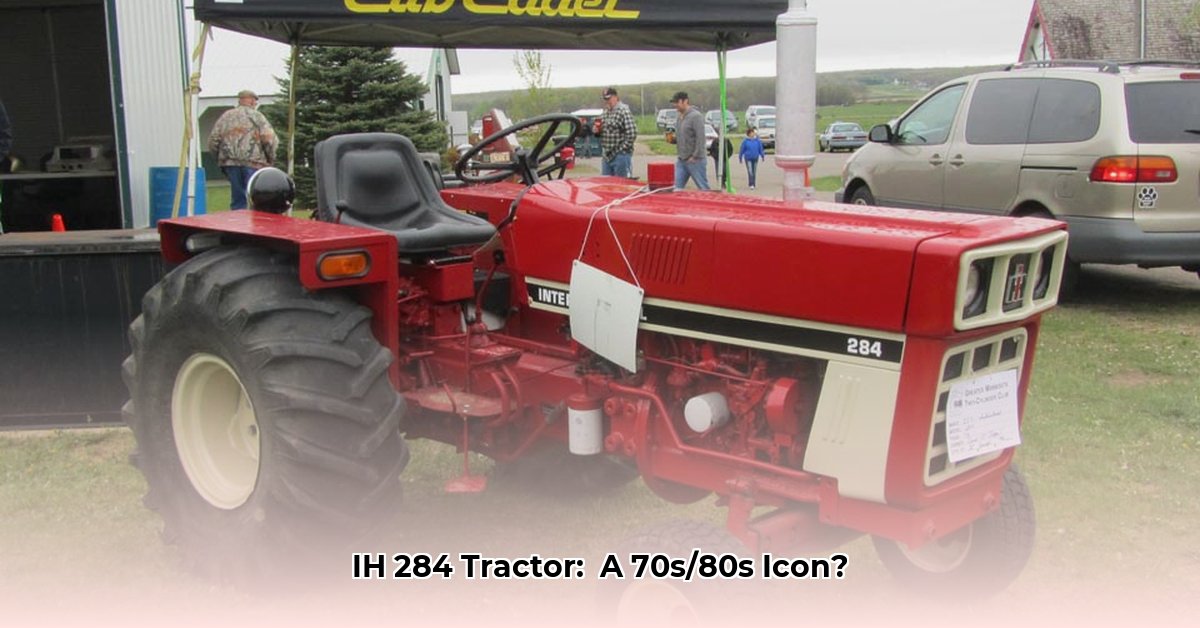
The International Harvester 284: a name whispered among tractor enthusiasts, a compact workhorse representing a pivotal era in agricultural technology. Produced during a time of significant economic and technological shifts in the late 1970s and early 1980s, this tractor's story reveals much about the challenges and innovations of its time. This article delves into the 284's technical specifications, historical context, market performance, and provides actionable insights for collectors, historians, and parts suppliers. For more on IH tractor pulling, see this great resource.
Technical Specifications and Design
The IH 284, a product of a collaboration between International Harvester (IH) and Komatsu, offered a unique blend of features. Its most distinctive characteristic was the choice of engines: a spirited Mazda gasoline option or a more fuel-efficient Nissan diesel, reflecting the era's energy consciousness. This versatility catered to diverse farmer preferences and economic realities. The eight-speed transmission provided a wide range of gearing for various fieldwork applications. While the hydraulics, featuring a 3.4-gallon reservoir, weren't designed for heavy lifting, they provided a respectable 2000-pound lift capacity—sufficient for many tasks. Curiously, four-wheel drive (4WD) wasn't initially standard, becoming available later as an option restricted to diesel models. Precise dimensions remain somewhat elusive due to inconsistencies in historical records, highlighting the challenges of reconstructing the past.
| Specification | Detail | Notes |
|---|---|---|
| Engine | Mazda Gasoline, Nissan Diesel | Power output varied slightly depending on the model and engine choice. |
| Transmission | 8-speed | Provided a wide range of gearing options for diverse tasks. |
| Hydraulic System Capacity | 3.4 gallons | Adequate for its intended tasks; it wasn't built for exceptionally heavy lifting. |
| Lift Capacity | Approximately 2000 lbs | This could vary slightly depending on attachments and specific usage. |
| Drive Type | 2WD (initially), 4WD (Diesel models later) | 4WD became a later option, exclusively for diesel-powered versions. |
Historical Context: Farming in Transition
The IH 284's production years coincided with a period of substantial change in American agriculture. Economic downturns significantly impacted farm profitability. Simultaneously, the manufacturing landscape evolved, with outsourcing becoming increasingly common. The IH 284 exemplifies this shift, with its production outsourced to Komatsu, a Japanese company. This decision likely stemmed from various factors, including cost-effectiveness and access to advanced manufacturing techniques. However, it also raises questions about the tractor's market perception—was it viewed differently because of its partial Japanese manufacturing? Comparing its performance to competitors like Ford, John Deere, and Massey Ferguson would provide invaluable context, though this requires detailed sales data, which is often difficult to obtain.
Market Performance and Legacy: A Niche Player
Precise sales figures for the IH 284 remain elusive, contributing to its enigmatic legacy. While its initial price was competitive (approximately $5,000 in 1984 dollars), it wasn't a top seller. Was its relatively lower horsepower compared to its competitors a limiting factor? Did its compact design, beneficial for some tasks, hinder its appeal to larger farms requiring more power? These questions remain open for debate. Further research into IH's internal documents and sales records could provide valuable insights into its market position and its impact on the IH product line.
Actionable Insights for Collectors, Historians, and Suppliers
The IH 284, despite not being a mass-market success, holds a unique place in agricultural history. This section offers actionable advice for various stakeholders:
For Collectors: Prioritize preserving originality. Join online forums dedicated to IH tractors to network, share knowledge, and source difficult-to-find parts. A robust online community is key for parts identification and sourcing.
For Historians: The IH 284 is a fascinating case study in the evolution of agricultural mechanization and the impact of outsourcing. Investigate company archives for sales data, marketing materials, and internal memos to gain a deeper understanding of its place within the broader agricultural landscape.
For Parts Suppliers: Despite its age, demand for IH 284 parts likely remains consistent. Focus on the most sought-after parts and consider reproduction efforts for particularly hard-to-find components. Focusing on commonly needed parts increases profitability and sustains the hobbyist community.
Conclusion: A Compact Legacy
The International Harvester 284, though not widely known, holds a significant place in the story of agricultural technology. It serves as a valuable example of the economic and technological transitions of the late 1970s and early 1980s. While further research is needed to fully understand its market impact, its story highlights the intricacies of agricultural innovation and the complexities of competing in a dynamic global marketplace. Its compact design, versatile engine options, and the intriguing international collaboration behind its creation make it a compelling subject for continued study and appreciation.